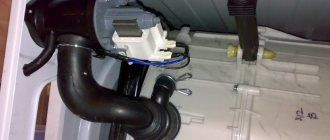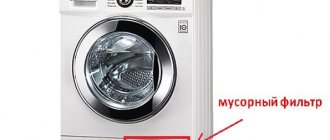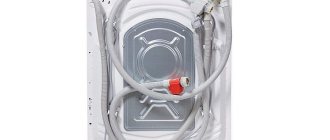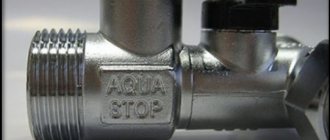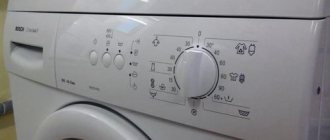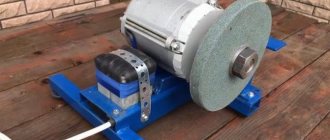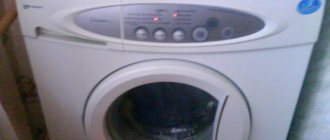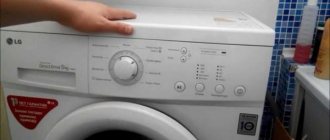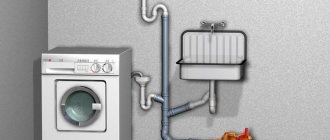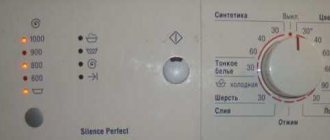Properly organized drainage of the washing machine will ensure its uninterrupted and high-quality operation. To do this, you will need to pay attention to some features. In the process of ensuring proper drainage, you should first inspect the washing machine hose designed for draining water and measure it. If it is not long enough, you will need to purchase a drain hose extension for the washing machine.
In addition, it is worth taking into account the diameter of the sewer pipe, which should be at least 4 cm. It is also important not to forget about the diagram according to which the unit’s motor is connected.
How to connect an automatic washing machine
Buying a washing machine usually entails two subsequent issues that will have to be resolved, no matter how you look at it. These questions are where to put it and how to connect the washing machine. I think we'll start in order...
Installation location of the washing machine
The first thing that comes to mind is to put a washing machine in the bathroom! But, the bathroom is a room with high humidity, and installing any electrical appliances in it is contrary to all existing rules (although who last followed them, eh?). But we follow the rules, and therefore the conclusion from here is this - connect the automatic washing machine directly in the bathroom simply through an outlet, not that it is impossible, but it is highly undesirable!
The solution options in the form of extending the original power cord or using a power extension cord are not constructive:
- extending the power cord automatically entails loss of warranty for the washing machine due to unauthorized changes in its design;
- An extension cord is an inconvenient thing for purely domestic reasons (at a minimum, an extended extension cord does not provide the opportunity to close the bathroom door, which in turn makes it difficult to pass in the corridor, and does not allow using the bathroom for its intended purpose while the machine is running). And suddenly water gets into it...
There remain two possible rooms suitable for safe, from an electrical point of view, installation of a washing machine - the kitchen and utility room, or some kind of storage room. Everywhere you go, they always advise installing a washing machine in the pantry. It seems to be dry there, warm and flies don’t bite; in general, an outlet can be built there without any problems.
In my opinion, those who give such advice have never lived in the Soviet Khrushchev - what other storage room or utility room?! Closet at most. They’ll copy some advice from English-language sites and be glad. Of course, the exception here will be fairly new houses, the layout of which includes such premises.
In general, I won’t rant further, I’ll just immediately note the pantry as a good place to install a washing machine.
Another option for installing a washing machine is in the kitchen. Quite justified, especially from the electrical safety point of view.
In a modern kitchen there are a lot of household appliances powered from the mains - a refrigerator, a freezer, an oven, a dishwasher, an electric kettle, a toaster, a double boiler, a microwave oven, etc.
All these household appliances require a separate power line and it would be logical to connect a washing machine to it, especially since the kitchen has both a cold water supply and a drain into the sewage system.
Electrical diagram for connecting a washing machine
Modern washing machines are powered by a 220 volt network with a frequency of 50 Hz. Everyone knows this. But not everyone knows under what load the wiring laid during the construction of a house is designed, this is especially true for panel houses in the above-mentioned USSR. Therefore, it would not be superfluous to lay a separate line to power the washing machine from the distribution panel, or better yet, to all appliances in the kitchen.
Such a line can be drawn both during a major renovation of an apartment, and without significant changes in the layout of the premises.
In order not to scratch the walls due to recently made repairs, the wiring can be hidden in special plastic boxes, of which there are a great many now.
The boxes are fastened using a hammer drill onto driven dowels if the walls are concrete or brick. It is best to fasten cable ducts on plasterboard sheets using Molly dowels.
The electrical circuit of the leased line is shown in the figure and includes:
- RCD - a short-circuit protective shutdown device, designed for a load of 32 A, provided that other household appliances are connected to this line;
- 3-core copper cable;
- socket or socket block with a grounding contact.
Connecting a washing machine - installing an RCD
The RCD can be installed by any manufacturer, at your discretion, the main thing is that it can withstand a load of 32 Amperes and has a unified body, as shown in photo 3, so that it can be installed in the panel without any problems.
Now about the cable. A copper cable with a cross-section of 3.5 mm will be sufficient.
The maximum consumption of the washing machine does not exceed 4 kW. 1 square millimeter of copper wire cross-section is designed to operate with a current of 14 amperes.
Therefore, if we apply the formula: power multiplied by 5 equals power consumption in amperes, we find that the washing machine consumes a maximum of 20 amperes.
Instead of a single socket, it is best to install a group of 4 or more (as in the picture), it will simply be more convenient - everything is in one place.
Which hose to choose
Before replacing a defective sleeve, you must purchase a new product of the required length and suitable for this washing machine. The retail chain has a large selection of hoses that differ in size and manufacturer:
- Standard. The length ranges from 1 to 5 m. Tips made of soft rubber are soldered into the ends. The diameters of the parts are different and are 19 and 22 mm. One part of the hose is attached to the drain pump pipe, and the other part is attached to the sewerage receiving device.
- Sleeve in a bay. It is convenient because you can buy a product of the desired length. Sold in bays. Assembled from 50 cm sections soldered together. The sleeve is cut off according to the existing serifs. End fittings are most often metal, but it is possible to install rubber tips.
- Telescopic. The assembled sleeve has a length of 0.6 m and can increase to 2 m. The negative side of such products is the large height of the corrugation, which leads to clogging and a decrease in the flow area. Susceptible to mechanical damage during stretching. When the pump operates, the product vibrates, which can lead to cracks.
An excessively long drain hose negatively affects the operation of the pump, leading to overload and failure. Sleeves should not be placed on the floor, because This leads to stagnation of water and the appearance of an unpleasant odor. The maximum distance from the machine to the drain should not exceed 3.3 m.
Cable monitoring
To ensure that the operation of the washing machine does not present you with unpleasant surprises, make sure that the cord that connects it to the power supply, as well as the plug or socket, does not heat up.
Heating of these elements can occur for the following reasons:
- The cross-section of the cable used for wiring is incorrectly selected. As a result, the cable does not withstand the load well, which contributes to heating of the washing machine cord;
- the wiring in the house is incorrectly installed;
- the wire connections are poorly made;
- use of low quality cable.
If the washing machine cord gets hot, it is advisable to fix the problem immediately. To do this, you need to determine how heating occurs: the cord is heated completely or only some part of it. Often only the plug gets hot. This occurs due to poor contact between the power cord and the outlet terminals.
Another reason for heating may be the use of an outlet rated for low current, for example, 10 Amps. For normal operation of a washing machine and other household equipment of similar power, a 16 Ampere outlet is required. This also applies to the electrical panel itself in the house. Heating is dangerous because it can lead to melting of the electrical outlet, and this in turn will cause a short circuit and fire.
If you notice heating of the cord or plug, you should also check the fastening of the cord to the washing machine itself. Sometimes it happens that a manufacturer, wanting to save money, connects a wire with a small cross-section (less than 2.5 mm) to the machine. In this case, it is necessary to replace the cord with a new one with a suitable cross-section. It is also important to remember that the plug must match the outlet. You cannot insert a Soviet plug into a Euro socket, since due to weak contacts inside the socket it will inevitably heat up.
You should also take the choice of an extension cord seriously, and it is best to abandon it altogether. Even a high-quality carrier can heat up if it is on a reel. This is due to the fact that the wound wire heats up faster due to the occurrence of inductance. To prevent this from happening, the coil is unwound when connecting a powerful electrical appliance.
Features of replacing the drain hose in units of different models
If it is impossible to extend the hose, it must be replaced. To do this, you should know the design features of the unit. Regardless of the model, the hose is connected to the drain pump. Its location differs in different units, and getting to it can sometimes be difficult.
The drain pump in washing machines Ariston, Samsung, Indesit, Ardo, LG is located at the bottom of the device. To access it, tilt or turn the unit over and remove the bottom cover and drain filter. Then unscrew the clamp and disconnect the tube. Install a new hose and perform all manipulations in reverse order.
Units from well-known brands Bosch and Siemens have a complex design. To access the drain pump and disconnect the hose, follow these steps:
- Remove the powder tray.
- Loosen the clamp securing the rubber cuff and remove it.
- Unscrew the bolts that hold the front panel of the washing machine and remove it.
Only after completing all the steps described above will you gain access to the pump and be able to remove the old hose.
When replacing the drain hose in a washing machine, take into account the design features of different models. The instructions for the unit will help you determine the location of the pump.
To access the drain pump in Zanussi and Electrolux washing machines, you need to remove the back wall. To do this, unscrew the screws holding the top cover and remove it. Then unscrew the bolts that secure the back wall. Remove the housing part and set it aside. Loosen the clamps and replace the hose.
In top-loading units, such as those from Beko, the drain pump is located on the side. To access it, you need to remove the side cover.
Extending or replacing the drain hose in a washing machine does not require special knowledge or skill. You can perform all the steps yourself. The main thing is to check the reliability of all fasteners at the end of the process and make sure there are no leaks.
Why is an extension cord prohibited?
In modern apartments there are practically no problems with connecting washing machines to the electrical network. Developers carefully consider the layout of bathrooms, providing several waterproof outlets for convenient and safe installation of household appliances. But in “old” houses, communications are not so well established: access to power is standard or even located far away, in the corridor or room. If there is no way to rebuild the room, there is only one option left - throw in an extension cord.
The scheme is simple: go to the nearest hardware store, buy the first extension cord you come across and turn on the washing machine through it. There is only one problem - doing this is strictly prohibited. This item is specified in each factory manual.
Connecting through an extension cord is considered dangerous for several reasons:
- Often an extension cord that is not suitable for power is purchased, or rather, it is too “weak” for the equipment;
- a energized “carrying device” lies on the threshold, next to the washing machine or in the corridor and, if exposed to water or touched, can give an electric shock;
- the cord connected to the socket under the door often frays, gets crushed and bent, the insulation is damaged, the wires are exposed and pose a threat to the life and health of the residents;
- Unknowingly, other devices are connected to the extension cord at the same time, which overstresses the network and results in an emergency power outage;
- Constant use of plugs of different types, especially pins that do not match in size, loosens the extension cord and does not provide a full current supply.
You can't joke with electricity. The human heart “works” from electrical impulses, and even a small surge in voltage from the outside will lead to malfunctions of the cardiovascular system. We must not forget about the fire hazard - damaged insulation and exposed wires can lead to a fire in equipment with further consequences.
Manufacturers of washing machines warn users and provide instructions for connecting the equipment to the electrical network. These include the supply of direct current of a certain power with grounding and protection from moisture. In most cases, the extension cord does not have such characteristics.
Features of choosing a surge protector - tips from the editors of Zuzako
When choosing a surge protector and/or extension cord for household use or connecting office equipment, it is recommended to pay attention to the following parameters:
- level of protection;
- presence of thermal protection;
- maximum permissible load;
- impulse compensation indicator;
- number, type and location of sockets;
- length of the wire and the possibility of its compact placement;
- Extra options.
Let us characterize the listed criteria in more detail.
Protection level
One of the main parameters that you should focus on when purchasing a filter. As a rule, the level is indicated directly on the product (packaging) and for the convenience of users is divided into three categories:
- Essential (minimal, basic). Smoothes out small voltage drops and has the simplest short circuit protection. Used to connect household and kitchen appliances, low-power power tools, lighting fixtures, etc.
- Home/Office (medium, advanced). The most common type of network filters. It has the optimal combination of cost and level of protection. Designed for computers, office equipment, televisions and other sensitive electronics.
- Performance (maximum, professional). It has the highest level of protection against all possible interference, from lightning protection to contact overheating. Some have built-in uninterruptible power supplies. Used to connect highly sensitive laboratory electronics and expensive office equipment.
Thermal circuit breaker (thermal protection)
When the quality of the electric current is low, the surge protector coils constantly work in enhanced mode. If all sockets are used, the device may overheat. The thermal cut-out switches the equipment off when temperature thresholds are reached. For budget models this is a bimetallic relay, for more expensive ones it is a thermal sensor controlled by a microcircuit.
Maximum permissible load
The ability to connect several powerful devices to the filter depends on this indicator. For example, most office (household) models have a load limit of 2.2 kW. This allows you to connect a computer and all peripheral equipment necessary for operation to one filter, the total load of which does not exceed 10 A. (10 Amperes × 220 Volts = 2.2 Kilowatts).
Pulse compensation indicator
The main task of the pulse compensation device is protection against voltage surges. The higher this indicator, the wider the smoothing range. This function is extremely necessary for old electrical networks. The parameter is indicated in kilojoules (kJ).
Number, type and location of sockets
The most common are surge protectors for 5-6 outlets. They are optimal for connecting a home or office computer unit: system unit, monitor, speaker, MFP/printer, backup for charging. Household extension filters usually have 3 outlets.
Sockets are located, as a rule, in one row. Sometimes one of them is located at some distance, which is convenient if you need to connect a plug with a large network adapter. Many premium products have sockets arranged in two rows, which makes the device more compact.
Not long ago, a new class of devices appeared and rapidly gained popularity - filters for one outlet without a cable. They are used to ensure a safe connection to one device, for example a TV, heating boiler, etc. Compact sizes make the use of such devices more convenient.
Length of the wire and the possibility of its compact placement
The choice of length of the surge protector wire depends on the specific requirements of the buyer. The most common are short extension cords of 1.2 and 1.8 m. 2-3 meter ones are slightly inferior to them in popularity. Filters with a cable length of 5 m are quite rare. For classic extension cords used outdoors, the cable length can be from 20 to 30 m.
Extra options
The following functionality and devices can be considered as additional parameters:
- protective curtains are installed on the openings of sockets, prevent dust from getting inside and protect from children's pranks;
- interface for connecting telephone and television lines, local networks and external Internet channels;
- separate shutdown buttons for each outlet;
- fasteners and lugs for vertical fastening.
Necessary materials
Before you go shopping, take the necessary measurements:
- Measure the length of the distance that was not enough to the sewer pipe (siphon) to determine the length of the tube. It’s better to buy a longer one and cut off the excess than not to cut it short. Initially, SM developers calculate the length of the drain based on the power of the pump, so adding extra meters increases the load on the pump. If the distance to the sewer is three times greater than the norm, this is fraught with pump breakdowns, stagnation of water in the hose, tank, and the appearance of an unpleasant “swampy” smell in the drum.
- Measure the diameter of the drain hose. It is desirable that the diameter of the additional one coincides with the “native” one. If the extension cord is narrow, it may be torn off by the pressure and a flood may occur.
Shopping list:
1. Hose extension.
It would be great if it was the same brand as the machine, but this is not necessary. The main thing is the required length and diameter. The cost depends on the length and quality - from 9 rubles to 200 and above. For example, for 200 rubles you can buy a corrugated, sliding one and independently adjust the length from 1.5 to 5 meters.
2. Connector.
It is also called a connector or fitting. Experienced mechanics and plumbers affectionately call this spare part “brush”. When choosing a part, you will need the previously measured diameter. Since the connector is double-sided, the cross-section of each side must coincide with the ends of the hoses. The cost may vary depending on the size and material, 10–20 rubles on average.
3. Clamps.
You will need two of them - to fix the end switches on the connector. A reliable option is plumbing or automotive metal clamps. The assortment allows you to roam - a variety of materials, models, sizes. Therefore, prices vary, but it is quite possible to buy one ring for 15 rubles.
4. Phillips screwdriver. To tighten the clamps, you most likely won’t have to purchase one; this tool can be found in any home.
What happens if the extension cord does not meet the requirements?
The inside of the extension cord is fragile, so you should run it along the walls, under furniture, in order to expose it to mechanical stress as little as possible.
If you deviate from the norms for connecting the refrigerator through the extension cord, various negative consequences are possible.
If the power of the connected household appliances exceeds the maximum permissible load on the extension cord, the current-carrying parts of the wires will heat up and the insulation will melt, followed by a short circuit, which can lead to a fire. It is worth considering that the refrigerator is operated around the clock, including in the absence of the apartment owner, so this rule absolutely cannot be neglected.
If there is no grounding on the device body, an electric current may flow in the event of a malfunction, which will threaten the life and health of equipment users. However, according to old Soviet standards, sockets in apartments did not have a ground wire.
If the electrical wire is subjected to frequent mechanical stress, for example, other household appliances are additionally connected to it, the cord is moved from place to place, it is stepped on when walking around the apartment, or there are strong kinks in the wire - this can lead to a break in the current-carrying parts of the extension cord, and as well as damage to their insulating coating. In this case, there is a risk of electric shock to a person, as well as a short circuit of exposed wires and fire. It is also possible that the wires may break or break, which will lead to the extension cord breaking.
If the refrigerator plug does not fit tightly into the wire connector, there is a play in the connection that can lead to heating of live parts, melting of the insulation and a short circuit with fire.
The decision to connect the refrigerator through an extension cord can be safe if you adhere to all of the above operating rules. In case of their violation, the violator himself assumes responsibility for the entire risk - from the serviceability of the household appliance to his own health and life.
Description of the cleaning process
There is no need to rush to grab water and soap: it is better to first carefully inspect the removed hose. Before you start cleaning, you should make sure that the rubber is intact, and if there is damage to the casing, you will need to replace it. Otherwise, unpleasant surprises with leaks will await you later.
You can remove most of the dirt by running an hour-long wash with baking soda and vinegar.
The cleaning itself is carried out using a special non-metallic Kevlar cable. There is a small brush at the tip, which is used to remove accumulated soap scum. To do this, just follow a couple of simple steps.
- Insert the device into the hose and, moving back and forth, remove the layer of dirt from the walls of the tube.
- Repeat the procedure several times until optimal cleanliness is achieved.
- Rinse the hose under strong pressure of hot water.
Instead of a Kevlar cable, a homemade analogue is suitable: bend one end of a long steel wire into a loop and tightly wrap a piece of fabric around it. The main thing is that the “brush” matches the diameter of the tube. In this case, the cleaning process is no different - insert, clean, rinse.
Features of organizing water drainage from a washing machine
Before you begin to disassemble the issue of connecting the washing machine drain, you need to know that water is pumped out of the machine using a pump, and a short drain hose reduces the load during its operation.
When organizing the drainage of water, a rather important point should be taken into account: the edge of the hose should not reach the water, as this creates an obstruction to the flow of water. If you do not take into account the considered features, then a problem with the operation of the washing machine may occur. For example, the display may display an error and the operation cycle may be interrupted.
Drain connection methods
You can connect the washing machine drain using one of several options:
- Using a special clamp - fixing the hose on the side of the bathroom or on the edge of the sink;
- Install the drainage hose and connect it to the siphon;
- Lay an additional drainage pipe elbow.
Any of the above methods is quite simple and does not require special knowledge and skills in handling plumbing. You can easily organize any method of drainage yourself.
How to replace?
The process of replacing the drain hose cannot be called simple, since this procedure requires disassembling the LG washing machine. It is attached not only to the body, but also to the drain pump, which is most conveniently accessible through the bottom of the device.
Preparation
To replace the hose, you will need the following tools and accessories:
- screwdrivers for tightening bolts;
- pliers for removing the clamp;
- cloth for collecting water.
To get to the hose, you will have to smoke the bottom panel, which is covered by the pump filter. Before proceeding with the main actions, perform the following preparatory activities:
- turn off the power to the washing machine;
- remove the hose from the sewer drain if it is inserted into the pipe;
- Carefully lay the washing machine on its side - one person will not be able to cope with such a task.
Only after the device is in a lying position can you begin to twist the panel behind which the mount is hidden.
Stages of work
To replace the hose you will need to do the following:
Open the cover located under the hatch on the front panel of the machine. The small hose sticking out is removed inside.- Tighten the bolt that holds the lower outer bar of the device. Underneath there are two more screws that need to be unscrewed. They are responsible for fixing the bottom.
- Use pliers to release the clamps that secure the hose to the pump. In this case, you need to make sure that water from it does not get on other parts. This may lead to their damage.
- Disconnect the tube from the pump and remove it.
- Fasten the new part, securely fixing it with a clamp. Return the pump to its place by bolting it to the body.
- Pass the hose behind the shock absorber so that it does not rub against the part and cracks do not form on it.
- Then thread the hose through the hole in the rear wall of the housing and screw on the bottom bar.
All that remains is to bring the part to the sewer drain and return the washing machine to its original place. After the repair has been completed, it is necessary to run a wash cycle to make sure that all parts are installed correctly and the machine is not leaking.
Video instructions for replacing the drain hose:
How to extend the hose
Sometimes, after purchasing a washing machine, we discover that the hose for draining the water is not long enough. It doesn't reach where it needs to be. Or you decided to put the machine in a new place and are faced with a situation where the existing hose is not enough.
What to do? Should I go to the nearest store that sells consumer electronics, to the department that sells washing machines, to get a hose of the required length? However, hoses are not of a standard size, are longer than usual, cost an order of magnitude more, and such a purchase can really cost a pretty penny. Try to solve this problem on your own. For this purpose, you need to select a drain hose extension for the washing machine, a suitable connector, and also prepare clamps.
First you need to determine what specific length of hose you need to add. To do this, you can use centimeters or a tape measure and measure the missing distance. After that, you need to purchase a plastic connector, a pair of clamps and one drain hose of standard length. Store shelves are full of a variety of types of connectors. It is better to choose one whose edges are not smooth, but like a herringbone. This allows you to increase the strength and reliability of the connection.
After purchasing the required materials, you can start extending the drain hose. First of all, you need to take a connector and use it to connect the drain hose of your washing machine with the one you just purchased.
The joints between the hoses and the connector should be tightened with clamps. The store can assure you that one clamp will be enough, but it’s better to be on the safe side than to defend yourself from flooded neighbors.
This design will serve you for many years to come. With a careful approach to the selection of all components and careful connection, you will never encounter a leak at the hose connection points.
Summing up
As you can see, organizing the correct drain for a washing machine is not so difficult and you can easily do everything yourself. If you approach this issue with all responsibility, spare no time and take into account all the required nuances, then your little assistant will reliably serve you for many years.
If you miss some features and do not organize the correct drainage of water, then the pump responsible for pumping water out of the washing machine may become unusable. And this will add worries not only in the form of inconvenience in the form of problems with washing, but also additional time and money spent on repairing the machine. Despite the fact that the cost of a new pump is quite significant, plus payment for the work of a specialist. It’s better to do everything conscientiously once and avoid problems in the future.
Share your opinion - leave a comment
When is replacement required, and when can you just clean the drain tube?
The drain hose is a corrugated tube that serves to drain water from the washing machine. It is attached to the drain pump, close to the pipe. Manufacturers of LG washing machines make this part from high-quality plastic that is resistant to chemicals.
It can have different lengths and colors; parts are available in grey, blue and white. There are also differences in the diameter of the internal and external holes.
The exact values are selected depending on the model of the washing machine. Replacement is required in the following cases:
Short length. The manufacturer always supplies the SMA with a hose included, but during installation, its length may not be enough. In this case, it will have to either be changed or expanded.- The product is damaged.
Most often this occurs due to mechanical force, such as a fracture of a flexible tube. Factory defects are rare, but they cannot be ruled out. If you find that the seal is broken, you must contact the service center. If the device is under warranty, the part is replaced free of charge. - Scale has accumulated inside the tube, or a blockage has formed, which cannot be eliminated without compromising the integrity of the hose.
If cracks are found, you should not try to insulate them. Such measures will not cope with the problem; leaks cannot be avoided.
How to clean?
You can understand that a blockage has formed inside the hose if you observe the washing machine. It can continue to drain the water, but the process will be slower. Often a clear sign of a blockage is an unpleasant odor emanating from the SMA.
A clog can be formed by a variety of debris. During long-term use, threads, lint, dirt, and dust lumps get into the hose. Limescale makes the situation worse.
As a rule, such blockages form gradually . Small objects can lead to sudden obstruction of the tube: buttons, coins, fasteners, etc.
If the blockage is caused by limescale, you can try to dissolve it without removing the hose. To do this, start a dry wash, adding citric acid rather than powder into the tray. This method is only suitable if the tube lumen is not completely blocked.
If you cannot do without dismantling, proceed as follows:
- disconnect the device from the network;
- drain the remaining water from the machine;
- remove the drain hose from the sewer, if it is installed in it - to do this you will have to remove the clamp;
- turn the machine on its side to gain access to its lower part, unscrew the bottom;
- remove the filter, which is bolted on;
- loosen the clamp responsible for fastening the hose to the pump and disconnect it.
Clean the tube using a cable, which is carefully rotated . This will remove even dense clogs. When the contents are outside, the hose is washed under running hot running water. If it goes through without delay, the part can be mounted in place by performing all the steps in reverse order.
What does connection actually look like in modern realities?
Considering the complexity of work in the bathroom, our people have come up with several ways to circumvent the ban.
- Buy a personal extension cord for only one device. In fact, another socket is also a kind of carrier, but laid in the wall according to all the rules of science.
- Carrying must be of high quality and grounded! Some people make their own, while others buy them in a store. For example, it has proven itself well. Its carriers are equipped with protection; in the event of a power outage or overheating, the device will turn off and prevent expensive equipment from burning out.
- Extend the cord to the required length. But here pitfalls emerge in the form of constant exposure of the door to the wire. It will gradually wear out and there will be a risk of short circuit, electric shock or fire.
The best way is to conduct grounded wiring from the panel directly to the bathroom and not worry!
Call the master
It is not always possible to replace the hose yourself. In this case, you need to seek help from a specialist.
Masters can be found by ad in the newspaper or on the Internet . If the machine is under warranty, then you should contact the store or service center. In order for repairs to be carried out free of charge, the owner must not be at fault for violating its integrity.
The cost of services for replacing a hose is about 1,200 rubles. The price of a new part is 1200-1600 rubles. It will have to be paid separately, regardless of the stated cost of repairs.
To avoid encountering scammers, before calling a technician to your home, you need to read reviews from other clients. It is advisable that they be posted on other resources.
The cost of repairs may vary slightly, but it should not be 2-3 times higher. If the master asks for payment in advance, his services should be refused .

